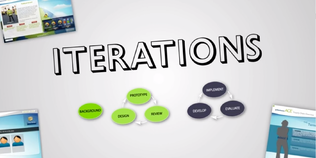Blog
Iterations: e-Learning that Focuses on the Learner
by Angel Green, Instructional Strategist


e-Learning Course Text: Less is More
By Allen Interactions | January 26, 2012 | Custom Learning | 0 Comments
 by Angel Green, Instructional Strategist
by Angel Green, Instructional Strategist
This week, while in a meeting with a client, I was asked a question, “How much text is too much?” My response– all of it.
Let me be clear: I hate words. I am a writer, and yet seeing lots of words, sentences, paragraphs and bulleted lists in e-learning raises my blood pressure and leaves me feeling defeated. First, I know the learner is not going to read them and second, I believe the words can go elsewhere.
Let’s focus on my first reason: the learner is not going to read them. We have plenty of experience witnessing that learners scan - not read - the words on screen, especially when there is a large amount of text. The fact that people read entire novels on tablet-like devices (a Kindle, an iPad or even their smartphone) has little to do with the fact that, in an e-learning course, learners still do not read large quantities of content.
Learners seek the path of what they need to do in order to complete the e-learning course. They want to get to the “good stuff’ – the interactions, the engaging pieces – as quickly as possible – and get it over with.
Our job as content writers, course developers and instructional designers should be to write as little words as possible. What content that does go into the e-learning course needs to be impactful and meaningful. We need to understand the mindset of our learners. We need to push a concept of less is more, and we need to identify alternative ways of delivering the content. Which leads me to my second point, words can be delivered elsewhere.
We’ve all suffered through it – the legal, compliance, executive committee or marketing team review our initial draft of a course (our alpha). Their response –“Looks great, but we need to tell them X.” So, we start adding in text.
Little by little our original, provocative, scenario based e-learning begins to transform into the typical, boring formula of an e-learning course: reading content and clicking Next. What started as a wonderful endeavor to provide learners with an engaging experience quickly morphed into a page turner with a couple of great interactions.
It happens to us, too – far more often than I’d like to admit.
What we need to do is gather empirical research and push our review team to look for alternative means of delivering that content. Are there PDFs that we can include? Are there links that we can send learners to for more information? Are there job aids we can reference, or develop, that can get the content the lawyers/compliance/executives say the learners must have without having it bog down our e-learning with a series of text screens?
When the answer is yes, we are good to go on our merry way of creating engaging and scenario driven content. But, when they balk at that, and they will, it becomes our duty to the learners to look for creative ways to deliver content.
We will have words we want/need/are required to include in an e-learning course. How we choose to present the words to our learners is up to us. Sure, we can give them long, passive text screens – asking them to click Next when they have finished reading. Or, we can think of unique ways to present content. When words are a necessary evil, it is our job to find the best way to give the learner that content.
I am sharing with you an example of a (relatively) easy and creative way to present content. Maybe this will spark some creativity and imagination.
In this example for our wonderful client DBi Services, it would have been easy to construct a static text page that told the learners that following the established safety requirements and protocols was vital to their job. However, we decided to use a creative and innovative way to give the same information in an entirely different manner. The focus of the learner is on one section of content at a time and the use of humor keeps the learner involved.
I hope this inspires you to think creatively, tell a story, incorporate media and images as often as you can and keep the learner engaged – even if they are only reading text. And, if you have some creative ways you have given the learner the words they need, please share them!
.png?width=135&height=135&name=ai-symbol-green%20(3).png)
About the Author: Allen Interactions
Comments
Would you like to leave a comment?
Related Blog Posts

By: Allen Interactions | Oct, 2013
Category: Custom Learning

Blog
What e-Learning Myths are You Nurturing?
by Angel Green, Instructional Strategist
By: Allen Interactions | Jun, 2012
Category: Custom Learning

Blog
All I Need to Know about Instructional Design I Learned from a Blue Jay
by Angel Green, Instructional Strategist
By: Allen Interactions | Jun, 2011
Category: Custom Learning
